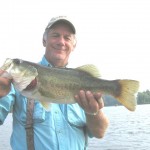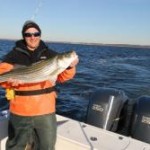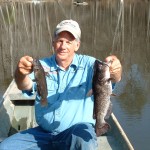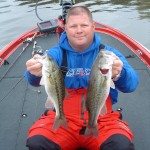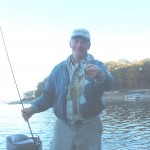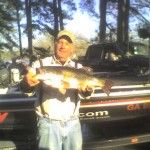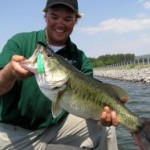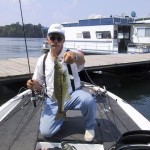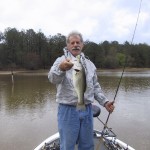Choices, choices. Fishermen in the central part of Georgia might have a hard time deciding where to go fishing this summer. From big lakes to farm ponds and from rivers to middle sized lakes we have many choices. Pick one of the mid-sized lakes in this part of the state and you will find willing bass. You may also find calm waters and relatively peaceful fishing.
In middle Georgia High Falls, Juliette and Tobesofkee offer excellent fishing but two of them have special motor restrictions you must follow. Those restrictions translate into calmer fishing but make it more difficult to cover water if you are used to zooming around in a fast bass boat.
Head to middle Georgia this month and fish one of these lakes. Each has differing cover, structure and age classes of bass so you can pick what you like best. Or fish all three for a variety of fishing experiences.
High Falls
High Falls is about two miles east of I-75 north of Forsyth. It is an old Georgia Power lake of 650 acres and all of it is a state park. The lake is closed from sundown to sunrise to boats and has very restricted bank access. Motors are limited to 10 horsepower or less but boats with bigger motors may be used if the motor is not cranked. State size and creel limits apply to the largemouth bass in the lake.
Located on the Towaliga River, High Falls is a very fertile lake and the largemouths grow big. According to the Georgia Department of Natural Resources, Wildlife Resources Division the numbers of bass in the lake has been increasing over the past several years and half of the keeper bass are over 15 inches long. High Falls ranks near the top of Georgia lakes for numbers of 15 to 25 inch bass
Ted Will, Regional Supervisor for the DNR WRD West Central Georgia Fisheries Management Division says the healthy population of largemouth coupled with the relatively low fishing pressure means you should catch good numbers of nice bass. There are many big bass in the lake so your chance of catching a quality fish is good at High Falls, too.
High Falls is shallow and most channels have filled in with silt over the years, making the bottom bowl shaped. It is full of stumps and other wood cover and that type cover is the key. Docks and brushpiles add to the amount of wood and there is a good bit of grass in the water by summertime.
Glen Jones and Tracy Parks live in the Griffin area near the lake and were childhood friends. They got back together a few years ago and fish the lake a lot with each other and with friends and family. Both have caught seven pound plus bass from High Falls. They have also fished some of the Jon boat tournament trails tournaments on the lake.
Worms are Glen’s and Tracy’s favorite baits and they fish both Texas and Carolina rigs. When fishing together they vary what each is using until the bass show them what they want. Glen likes big worms and will usually start with a Zoom Old Monster or a Chompers 10 inch worm. Tracy will rig a smaller worm like a Zoom U-Tail on his Texas rig. For Carolina rigs Glen will start with a Zoom Mag 2 and Tracy will usually start with a Zoom Trick worm.
Fish worms through and around any wood cover you can find. Most docks are on posts and have brush piles around them. Stump beds are common in many areas of the lake and you will see blowdowns on banks all around the lake. All hold bass.
Topwater baits are also good and Tracy likes a white buzz bait with Glen following up with a Chug Bug or Pop-R. Spinnerbaits and Rattle Traps will catch fish, too. All these baits are fished along grass edges and over shallow grass to draw strikes.
You can put in using the ramp at the park at the dam and work up from it. The left bank going up is lined with docks while the right bank is open. The state park campground is on the right side. Above it there are some areas with stumps and grass beds to fish. With a small motor it will take a good while to get to the area where Buck Creek, Watkins Bottom and Brushy Creek split into arms off the river.
If you put in on Buck Creek at the ramp there you will be closer to more shallow fishing. Buck Creek is full of stumps and docks not far above the ramp and bridge. Just downstream of the bridge Brushy Creek enters on the left and has good fishing around wood and grass. Out and across the Towaliga River is Watkins bottom that is similar.
One good summertime pattern is to go up the Towaliga River as far as you can. Where the lake narrows down to just river channel you will find some good flats with grass to fish and up in the channel you can flip to blowdowns and overhanging brush to catch some big largemouth. Many tournaments are won on that pattern. Just make sure you leave plenty of time to be back at the ramp and off the lake by sundown.
Juliette
Lake Juliette is a 3600 acre Georgia Power lake about 15 miles east of I-75 and Forsyth. It provides water for coal fired Plant Scherer and has little inflow from Rum Creek so the water stays very clear. Juliette is filled each spring by pumping water from the nearby Ocmulgee River. Since the water is so clear grass grows all over the lake and down to surprising depths.
Standing timber was left when the lake was built. On the lower lake it was topped out well below the surface in most areas but the upper lake is filled with stumps right at the high water line. You must follow the channel in that area.
Motors are limited to 25 horsepower on Juliette but you can put in boats with bigger motors if you don’t crank them. The lake is too big to effectively fish with just a trolling motor, though. Much of the best summer fishing is out in open water and you can fish at night but you must be very careful due to the standing timber.
Ted Will and the WRD say the lake is infertile and populations of largemouth are lower than most middle Georgia lakes. Due to the slow growth rate there is no size limit on bass on the lake so you can keep ten bass any size. The lake is on a Wildlife Management Area but you need only a Georgia fishing license, no WMA stamp is required to fish here.
Baitfish in the lake include big gizzard shad and blueback herring. The bluebacks complete with bass fry for food and even eat them and the size of the herring and gizzard shad means it is tough for a small bass to grow to a size big enough to eat them. This may create long term problems for the lake but right now there are more than enough bass fry and small bass in the lake.
Although populations of bass are low there are good numbers of quality bass in the lake. About one-fourth of the bass are 15 inch long or longer and average bass caught weigh about a pound and a half. Monster bass weighing 12 to 16 pounds have been caught from the lake and it is not unusual for a tournament limit of five bass to weigh 20 pounds at the monthly tournaments on the lake.
The timber and the grass combine to offer lots of cover for bass and they are key to catching them. Grass lines form in deep water and standing timber with the grass just improves the fishing. The blueback herring in the lake mean bass are oriented to the surface during the summer.
Chad Hitt grew up in Forsyth and he and his father fish together in the monthly tournament at Juliette. They have been consistent in their catches and last year through nine months they had a 3.2 pound average for the fish they weighed in. Their best five-fish limit in a tournament weighed 17.66 pounds and their biggest bass was a 6.11 pounder. Chad’s best bass from Juliette is a 7.75 pound fish.
Bass at Juliette hold fairly deep, from 10 to 18 feet in the summer and fall, according to Chad. They hold in the grass and wood cover and will come up and eat a bait worked over them or through the cover. Topwater and worms both work well now.
Chad will start out with a topwater plug like a Pop-R or Rico and fish the grass line around the bank. There is often a visible grass line where the hydrilla grows up to the surface then drops off. There will be grass deeper than the line but the bass often hold near it. Fish at an angle working your popper close to this drop.
If the bass don’t want the topwater bait or after the sun gets high Chad will switch to a Texas rigged Zoom Mag 2 worm with a fairly light lead to fish through the grass. He works it slowly moving it through the grass where the bass are holding. If the bottom is clean with little grass Chad will switch to a jig head Trick worm and fish it on the bottom.
You can put in near the dam to fish the open lower end of the lake. There are many good pockets and small creeks with grass and timber in them, and the humps and shallows on the main lake are covered with grass beds. The open water in this area can get rough in a hurry when the wind gets up so be careful in small boats.
The upper end of the lake has a ramp and it is right in the standing timber. Follow the channel in this area because most of the trees have rotted off right at the high water mark. If the lake is down a little you can see many of them but if it is full it is very dangerous.
In this area fish the points and creek channels in the timber. You will see an old road bed crossing the lake between the ramp and the power plant and both ends of it can be good, too. There will usually be grass on these spots mixed in with the wood and you will need to fish it slowly and carefully to cover the places a bass will hold. Use heavy tackle so you can get them out of the wood when you hook a fish.
Tobesofkee
Lake Tobesofkee is a 1750 acre lake owned by Bibb County and located a couple of miles west of I-75 in Macon. It is ringed with houses and there are several parks open to the public on the lake. The lake gets very crowded in the summer with pleasure boaters and skiers since there are no motor restrictions.
The lake has a good bit of rock and grass cover in it and there are many brushpiles built by fishermen. The docks around the lake also add to the type of cover the bass like. State size and creel limits apply and you must have a Georgia fishing license. Access to the lake is expensive at the county operated parks.
Will says there are lots of keeper size bass in the lake and fishing has been improving for the past several years. Good spawns two and three years ago mean large numbers of those year class bass are reaching keeper size and better now. You should be able to catch a lot of 12 to 14 inch bass at Tobesofkee this summer.
Local pot tournaments move to night fishing this time of year because of the crowds during the day and the fishing is better in the dark. Weekdays are not too bad but you can hardly fish the lower lake on a pretty weekend summer day. The upper lake offers some protected shallows with grassbeds and brush that holds fish but that area is better late or early in the day as well as at night, too.
Ricky Randall has lived in the Macon area all his life and has fished Tobesofkee often. He fished with two local bass clubs and now he and his dad fish mostly pot tournaments. They often get a check at the weekly tournaments on Tobesofkee.
A few years ago Ricky and his dad had their best catch ever on the lake, seven keepers that weighed 30 pounds on a day they just went to the lake to check it out since the water was low. They have weighed in a six bass limit at just over 21 pounds in a tournament there.
Weedbeds and riprap are good places to catch bass on Tobesofkee and Ricky fishes them with a variety of baits. He will parallel the rocks with a small crankbait like a #5 or #7 Shadrap then go back along it with Trick worms and a jig and pig. The grass beds are water willow and they are fished with Trick worms, topwater and a jig and pig.
A lot of bass at Tobesofkee will hold around 14 to 15 feet deep on structure and cover out on the lake. Ricky will look for schools of shad and expects bass to be on the closest brushpile or channel drop. A big plug like a Mann’s 20 Plus, Norman DD22N or Fat Free Shad will catch them when cranked down to the depth they are holding.
You can put in near the dam at the big county park and fish all over this small lake if you have a bass boat. The creeks that go back under Mosley Dickson Road on your right as you go up the lake all have good riprap to fish as does the bridge up the river on Lower Thomaston Road. Those creeks and the structure near the mouths of them hold fish this time of year, too.
The lake will narrow down then open back up above the bridge on Lower Thomaston Road. This big area has several small feeder creeks with grass lining them and are good places to fish. They are more protected than the lower lake but skidoos and skiers still make it difficult to fish even here in the summer.
Try these mid-size lakes in the middle of Georgia for different kinds of bass fishing this summer. Explore them to find honey holes that will pay off in numbers of bass as well as some big fish, especially on High Falls. All of them will provide good fishing and you can find peace and quiet on two of them if that is what you are looking for while bass fishing.
